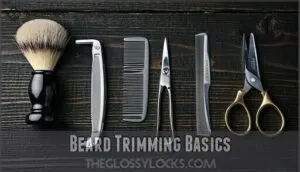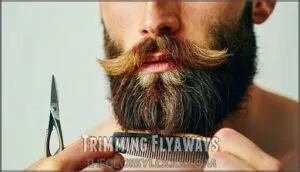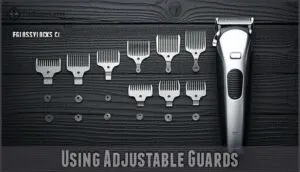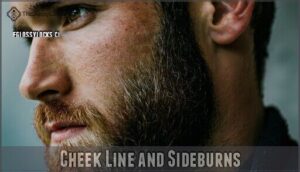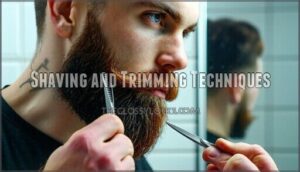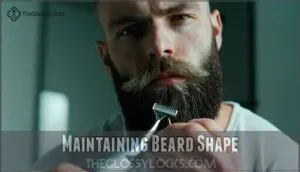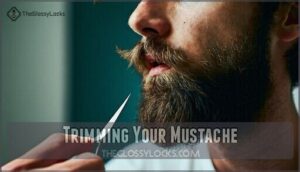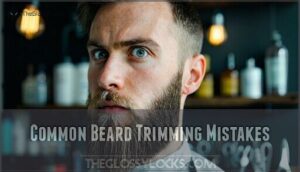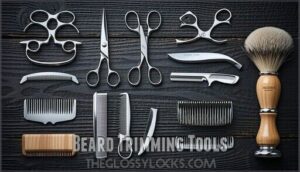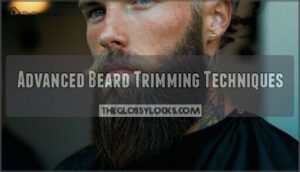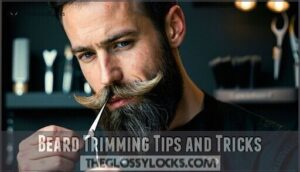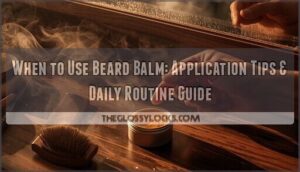This site is supported by our readers. We may earn a commission, at no cost to you, if you purchase through links.
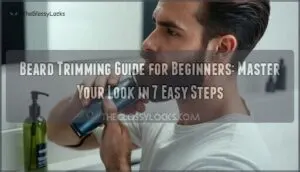 Start your beard trimming guide for beginners journey by washing and drying your beard completely. You’ll want to use a quality trimmer with adjustable guards – think of them as training wheels for your face.
Start your beard trimming guide for beginners journey by washing and drying your beard completely. You’ll want to use a quality trimmer with adjustable guards – think of them as training wheels for your face.
Begin with a longer guard setting and work your way down gradually. Trim with the grain, not against it, to avoid irritation and patchy spots.
Define your neckline by placing two fingers above your Adam’s apple – that’s your cutting line. Don’t forget to trim stray hairs around your cheek line for clean edges.
The secret lies in trimming little and often rather than hacking away like you’re clearing brush.
Table Of Contents
- Key Takeaways
- Preparing Your Beard
- Beard Trimming Basics
- Trimming Your Beard
- Defining Your Beard Lines
- Maintaining Beard Shape
- Trimming Your Mustache
- Common Beard Trimming Mistakes
- Beard Trimming Tools
- Advanced Beard Trimming Techniques
- Beard Trimming Tips and Tricks
- Frequently Asked Questions (FAQs)
- Where should my beard neckline be?
- Is it better to trim beard wet or dry?
- How do you trim your beard for the first time?
- Does trimming a beard make it grow thicker?
- Should I trim my beard while growing it?
- How should I trim my beard for beginners?
- What is the rule 5 for beards?
- When should you trim your beard?
- How to trim a beard?
- How do I choose a beard trimmer for grooming?
- Conclusion
Key Takeaways
- Start with clean, dry hair and use quality tools – wash your beard thoroughly, then begin trimming with the longest guard setting and work your way down gradually to avoid over-cutting.
- Define your neckline properly by placing it one finger’s width above your Adam’s apple, creating a curved line from ear to ear to frame your face correctly.
- Trim with the grain, not against it, using steady downward strokes to prevent irritation, patchy spots, and uneven cuts that’ll ruin your look.
- Establish a regular trimming schedule of every 7-10 days to maintain your beard’s shape, since consistency beats perfection and prevents your facial hair from becoming an unruly mess.
Preparing Your Beard
Before you grab those trimmers, you’ll need to set up your beard for success with proper washing, drying, and combing.
Think of it like prepping a canvas before painting—skip this step and you’ll end up with uneven cuts that’ll have you wearing a hat for weeks, which is why proper preparation is key.
Washing and Towel Drying
Proper preparation sets the foundation for a perfect trim.
Your beard deserves the same attention you give your hair. Skip regular soap – it strips natural oils and leaves your facial hair brittle.
Here’s your beard washing routine:
- Use a dedicated beard shampoo or beard wash designed for facial hair
- Work the product through wet whiskers with warm water
- Follow with beard conditioner for softening hairs and easier detangling after
- Pat dry gently – aggressive towel drying damages hair cuticles
Clean, soft whiskers make trimming smoother and more precise.
Brushing and Combing
With your freshly washed beard still damp, grab your beard comb or beard brush – your beard grooming game-changer.
For shorter whiskers, a fine-toothed comb works perfectly. Longer beards need a boar bristle brush.
Work through hair following its natural growth direction, starting from your neckline upward. This detangling benefits your beard maintenance routine while creating styling effects that’ll make heads turn.
Think of it as your daily beard grooming ritual.
Removing Tangles and Flyaways
Tackling those stubborn tangles and flyaways requires the right approach and tools.
Start with a beard comb for initial detangling methods, working from tips to roots. Switch to a beard brush for flyaway prevention and smoother results.
Comb selection matters – wide-toothed for thick hair, fine-toothed for precision. Apply beard oil as product application before brushing your unruly beard.
These detangling and trimming techniques prepare your whiskers perfectly, making the actual trim much easier and more effective.
Beard Trimming Basics
You’ll need to understand three key things before you start cutting: how often to trim, what length works for your growth rate, and which tools actually matter.
Think of this like learning to drive a car – you wouldn’t jump behind the wheel without knowing the basics first, and the same goes for your beard.
Trimming Frequency
Now that your beard’s clean and ready, you need to figure out your beard trimming frequency.
Most guys wonder how often they should grab those clippers.
Your beard trimming schedule depends on several factors that make each person’s routine unique:
- Fast growers might need weekly touch-ups to keep their style sharp
- Slow growers can stretch it to every 10-14 days without looking scruffy
- Seasonal trimming changes – summer heat means more frequent maintenance
- Personal schedule matters – busy weeks call for lower-maintenance styles
Beard length and growth stages play huge roles here.
Short beards need constant attention, while longer styles forgive a few extra days.
Style maintenance becomes easier once you nail down your natural growth pattern.
Skip the guesswork and track your beard’s behavior for two weeks.
Length and Growth Rate
Understanding your Growth Stage transforms you from beard rookie to grooming pro.
Your facial hair won’t grow like clockwork – it’s more like herding cats.
Most guys see about half an inch monthly, but Uneven Growth keeps things interesting.
Some patches sprint ahead while others take their sweet time.
Growth Direction varies too – your chin hairs might grow straight down while cheek hairs curve sideways.
Here’s your roadmap for beard growth stages:
Initial Wait matters most – give new beards four weeks before serious beard trimming.
Tools and Equipment
You need the right grooming kit to achieve professional results at home.
Start with a quality beard trimmer featuring adjustable guards—this becomes your go-to tool for consistent length control.
Sharp beard scissors provide scissor precision for detailed mustache work and stubborn strays.
A sturdy beard comb helps with comb selection based on your beard’s thickness, while a razor offers clean edging for necklines and cheek definition.
Don’t overlook maintenance tools like beard oil and brushes—these beard products keep everything manageable between trims.
Consider purchasing a complete trimming set for convenience.
Quality beard trimming tools make all the difference!
Trimming Your Beard
Now you’re ready to tackle the actual trimming, which is where most guys either nail it or accidentally turn their beard into a patchy mess.
Start with your trimmer on the longest setting and work your way down gradually, because you can always trim more but you can’t magically grow hair back in five minutes, and this approach helps prevent a patchy mess.
Trimming Flyaways
Those rebellious strands sticking out everywhere? Flyaway Causes range from dry hair to static electricity, but don’t worry – taming them is easier than you think.
These stray hairs love to ruin your otherwise perfect beard, making you look like you stuck your finger in an electrical socket.
Here’s your battle plan for Preventing Flyaways:
- Start with a clean, dry beard to spot problem areas clearly
- Use a fine-toothed comb to lift those rebel strands
- Trim with small scissors held parallel to your face
- Work in small sections from bottom to top
- Apply beard balm for Product Control and lasting hold
These Trimming Methods give you Long-term Solutions that keep flyaways manageable between full trims.
Using Adjustable Guards
When choosing your guard length guide, think of it like selecting the right wrench for a bolt.
Start with a higher guard number (#4 or #5) for your first pass, then work down gradually, this consistent trimming approach prevents disasters and builds confidence.
Guard numbering runs opposite to length – lower numbers mean shorter cuts, always check guard maintenance by ensuring it clicks securely before each trimming session, avoiding over-trimming mishaps.
This approach helps to ensure that you are using the right guard for the job, and by following these steps, you can achieve a successful trim.
Trimming in Straight Lines
With your guard secured, master straight line trimming techniques that create perfect edge definition.
Move your trimmer in smooth, downward strokes while keeping the blade parallel to your skin.
This guarantees consistent length and line symmetry throughout your beard.
Use your jawline as a visual guide, avoiding curves that create uneven patches.
Steady movements prevent those rookie mistakes that’ll haunt your reflection.
Defining Your Beard Lines
Now you’ll shape the borders that make your beard look sharp and intentional.
Think of these lines as your beard’s frame – they separate the hair you want to keep from the hair that needs to go.
Neckline and Jawline
After trimming your beard’s overall length, you’ll want to define your neckline placement and enhance your jawline.
Find your Adam’s apple and trim just above it, creating a curved line to each ear.
This natural fade improves facial symmetry and prevents the dreaded chin-strap look.
A well-defined neck line adds beard weight where it counts, making your jawline pop like a champ.
Cheek Line and Sideburns
After nailing your neckline, it’s time to tackle the cheek line and sideburns. These areas frame your face and can make or break your beard shaping efforts.
Defining cheeklines requires patience and precision. Start by identifying your natural cheek line – that’s where most of your beard hair naturally stops growing upward. You can follow this line for a rugged look or create a slightly higher line for something cleaner.
Your sideburn styles should complement your haircut length. Here’s how to nail the perfect connection:
- Trim sideburns to match your hair’s fade level
- Use fading techniques to blend seamlessly into your beard
- Maintaining symmetry is key – check both sides frequently
- Connecting lines should flow naturally from hair to beard
- Work slowly with your beard trimming tools
Shaving and Trimming Techniques
With beard trimming techniques for beginners, mastering your lines becomes second nature.
Start with trimmer guards at your Adam’s apple, working upward in smooth strokes. Your tool choice matters—use scissors for scissor precision on individual hairs, trimmers for broader areas.
Follow growth direction when shaping cheek lines from sideburns to mouth corners. Line fading creates natural transitions by gradually reducing guard lengths.
Sharp blades paired with quality shaving cream prevent irritation and missed spots. Remember, beard trimming for beginners requires patience.
Take breaks between passes to assess your progress. This beard trimming guide for beginners emphasizes steady hands over speed for professional results.
Maintaining Beard Shape
You’ve shaped your beard perfectly, but like a garden hedge, it won’t stay that way without regular care.
Trim every 7-10 days and brush daily to keep your beard looking sharp and prevent it from turning into a wild mess.
Regular Trimming
Your beard’s maintenance schedule matters more than you think. Regular trimming keeps your facial hair looking intentional, not accidental.
Most guys need a beard trimming session every 7-10 days to maintain that consistent shape. This frequency benefits your overall appearance and promotes healthy growth by removing split ends and straggly hairs.
Beard grooming isn’t complicated once you establish your personal schedule. Short beards demand more attention—think every few days. Longer beards can stretch between sessions.
The key is consistency to prevent messiness from taking over. Your growth rate dictates the rules here. Fast growers might need twice-weekly touch-ups, while others cruise with weekly sessions.
These trimming tips aren’t just about looks—regular maintenance trains your hair to grow in the right direction. Skip sessions, and you’ll fight uneven patches later.
Combining and Brushing
Regular trimming keeps you on track, but daily combining and brushing transforms your beard from scruffy to sophisticated. Think of it as training your facial hair to behave properly.
Brush Types matter – boar bristle works best for thick, coarse hair while synthetic handles finer textures. Comb Material like wood or horn prevents static and breakage better than plastic.
Your Detangling Techniques should follow natural Growth Assessment patterns. Brush downward, distributing oils evenly throughout. These Styling Benefits include better beard grooming control and healthier beard care. A quality beard brush makes all the difference in achieving professional beard styles.
Trimming Your Mustache
Your mustache can make or break your entire beard look, so don’t let it become an unruly mess that covers your upper lip like a hairy curtain.
Follow the shape of your lips when trimming, and remember that small adjustments work better than big chops since mustache hair grows slower than you think, which is a key consideration to maintain a well-groomed beard look.
Styling and Shaping
Your mustache deserves the same attention as your main beard. Start by determining your face shape – it’ll guide your styling choices perfectly. Round faces benefit from wider styles, while square faces look great with fuller, bushier looks.
Channel your inner artist: Your face becomes the canvas, your trimmer the brush. Express your personality through different beard styles that complement your overall look.
Comb it out first, then use beard shaping techniques to create definition. Consider hairstyle pairing – your mustache should harmonize with your haircut. Quality beard products help hold the shape you’ve crafted. Remember, style guides exist, but confidence trumps trends every time.
Trimming and Maintaining
While your mustache might seem like a minor detail, proper trimming keeps your overall look polished and prevents hair from tickling your lips during meals.
Start by combing your mustache downward to reveal its natural Growth Patterns. Use small scissors or a precision trimmer to carefully trim along your lip line. Take your time – you can always cut more, but you can’t put it back. After trimming, do a Symmetry Check in good lighting to confirm both sides match.
clear lines and symmetry.
Apply Beard Oil and Styling Products to keep everything in place. This beard trimming technique separates beginners from pros. Remember, consistent beard maintenance beats perfection every time!
Common Beard Trimming Mistakes
Even experienced guys make rookie beard trimming errors that can turn a great look into a month-long regret.
You’ll save yourself time and frustration by learning these three common mistakes before they happen to you, which can help you avoid rookie beard trimming errors.
Trimming Against The Grain
Going against your beard’s natural Hair Direction is like swimming upstream – you’ll fight every stroke.
This common beard trimming mistake creates serious Irritation Prevention issues and Evenness Concerns that’ll leave you looking patchy.
Here’s why Technique Refinement matters for beard trimming for beginners:
- Prevents painful skin irritation and razor burn
- Stops hair breakage that creates uneven patches
- Reduces ingrown hairs and bumps
- Maintains healthy Growth Impact patterns
Follow your beard’s flow instead.
Not Using Guards
While trimming against the grain can damage your whiskers, skipping guards altogether is like driving blindfolded. You’re asking for trouble.
Guards aren’t training wheels you outgrow – they’re precision tools that prevent disasters. Even experienced groomers rely on them for consistent results. Without guards, your beard trimmer becomes an unpredictable weapon that can wreck months of growth in seconds.
Here’s what happens when you go guardless:
- Skin irritation from blade contact with sensitive areas
- Patchy, uneven length that screams amateur hour
- Over-trimming that requires weeks to fix
- Increased nicks and cuts around jawline curves
- Zero control over blending techniques between sections.
Freehand shaping belongs in advanced trimming territory, not beginner beard trimming guides. Guards give you the confidence to experiment without fear. Start with longer settings and work your way down. Your future self will thank you for playing it safe during those early beard trimming mistakes.
Not Trimming Regularly
Your beard becomes a jungle without consistent maintenance. Skipping regular trims leads to an unkempt appearance that screams neglect. Patchy growth becomes obvious, while shape degradation ruins your carefully crafted look.
Itchiness increase makes daily life uncomfortable, and styling difficulty turns grooming into a nightmare. Most beard trimming mistakes stem from inconsistent care.
This beard trimming guide for men emphasizes routine maintenance. Beard trimming tips for beginners always include scheduling regular sessions. Don’t let procrastination destroy months of progress.
Full reshape
Beard Trimming Tools
You can’t build a house without the right tools, and the same goes for trimming your beard.
Having quality scissors, trimmers, clippers, and razors makes the difference between a sharp, professional look and a backyard haircut gone wrong.
Scissors and Trimmers
Poor technique leaves you with patchy results, but the right tools make all the difference. Scissors and trimmers form your beard-trimming foundation.
Your beard deserves better than guesswork—master the fundamentals and trim with confidence, not chaos.
Scissor precision lets you tackle individual hairs with surgical accuracy, perfect for detailed work around your mustache. Trimmer advantages include speed and consistency for bulk trimming.
Here’s your tool breakdown:
- Corded vs cordless – Corded offers consistent power, cordless gives freedom
- Beginner kits include multiple guards and accessories
- Tool maintenance means cleaning blades after each use
Your beard trimmer handles the heavy lifting while scissors add finishing touches. Selecting the right beard grooming tools guarantees a precise trim.
Clippers and Razors
Electric trimmers and clippers tackle the heavy lifting of beard maintenance, while razors handle precision work.
Your beard trimmer becomes your best friend for bulk trimming and maintaining consistent length. Corded vs cordless models each have benefits – corded provides consistent power, while cordless offers mobility.
Here’s your toolkit breakdown:
- Clippers: Perfect for maintaining length with proper guard selection
- Electric trimmer: Ideal for detailed work and flyaway control
- Razor: Essential for clean necklines and preventing razor burn
Blade sharpness directly impacts your results. Dull blades tug and cause irritation. Regular clipper maintenance keeps your tools performing like new. Sharp blades glide smoothly, reducing skin irritation.
Consider browsing options for specialized beard tools for superior results. Remember, quality tools make trimming easier and more enjoyable.
Choosing The Right Tool
Your beard type determines everything.
Thick, coarse hair needs powerful beard trimmers with strong motors. Stubble requires fine adjustments and razor precision.
Trimmer vs scissors? Adjustable trimmers handle length, while scissors nail detail work.
Consider comb types for measuring cuts. Don’t forget tool maintenance – sharp blades mean cleaner cuts.
Match your beard grooming tools to your facial hair’s personality, and you’ll transform from caveman to gentleman effortlessly.
Advanced Beard Trimming Techniques
Once you’ve mastered the basics, you’re ready to tackle professional-level techniques that’ll make your beard look like you stepped out of a barbershop.
These advanced methods involve fading, layering, and precise shaping that transform a simple trim into a work of art.
Fading and Layering
Creating gradient styles with your trimmer transforms any basic beard into a masterpiece. Fading involves trimming hairs to different lengths, creating seamless blends without harsh lines. Layering adds texture variation by using longer settings on bulk areas and shorter ones on edges.
Here’s your roadmap to blending hairs like a pro:
- Start longest, work shorter – Begin with your trimmer’s highest setting and gradually decrease
- Trim in one-inch sections – Work systematically from jawline up to sideburns
- Use progressive guards – Switch to closer settings as you approach the neckline
Shaping and Styling
Once you’ve nailed fading, it’s time to sculpt your masterpiece. Shaping a beard is like being an artist—your face is the canvas.
Consider your face shape when choosing style variations. Round faces benefit from angular cuts, while square faces need softer edges.
Product application is key here—beard balm helps hold your beard style while oil adds shine. Work the product through, then comb into your desired shape.
Remember, good beard aesthetics complement your hairstyle pairing. Practice makes perfect with these beard trimming tips.
Maintaining and Trimming
Once you’ve shaped your beard, keeping it sharp requires consistent attention. Your facial hair grows at different rates, so regular maintenance prevents that "wild mountain man" look from creeping back in.
Here’s your maintenance playbook for advanced beard trimming techniques:
- Schedule barber visits every 4-6 weeks for professional shaping and neckline precision
- Apply beard oiling daily to promote growth stimulation and keep hair soft for easier trimming
- Use styling products like balm benefits to control flyaways before trimming sessions
Master these beard trimming tips and you’ll maintain crisp lines effortlessly. Remember, consistent beard trimming advice focuses on small, frequent adjustments rather than dramatic changes. Your beard trimming techniques improve with practice, making each session more efficient than the last.
Beard Trimming Tips and Tricks
You’ve learned the basics, but smart trimmers know that small tricks can make the difference between a decent beard and one that turns heads.
These practical tips will help you avoid rookie mistakes and develop the confidence that comes from knowing exactly what you’re doing.
Trimming Wet or Dry
Wet Beard Shrinkage tricks many beginners into over-trimming. When you trim wet hair, it appears longer than reality—then shrinks as it dries, leaving you with an unexpectedly short beard.
Dry Beard Accuracy gives you the true picture. Dry trimming shows exact length and Hair Texture Impact on your final look.
Tool Performance Difference matters too—clippers glide smoother through dry hair, while wet hair clumps and clogs blades. For best beard trimming techniques, always trim dry.
Apply grooming tips like beard oil after trimming for Product Application Timing that enhances your beard guide results.
Trimming for Growth
Growing a great beard isn’t just about trimming—it’s about strategic patience.
Your beard oils work overtime to promote growth stimulation while you resist the scissors.
Here’s your growth game plan:
- Initial Shaping only after 4-6 weeks of untouched growth
- Maintaining Fullness by trimming just flyaways, not length
- Even Growth through consistent care and minimal interference
- Natural Shape emerges when you let genetics lead the way
Rome wasn’t built overnight, and neither was your magnificent mane.
Common Mistakes to Avoid
Every beginner makes beard trimming mistakes, but you can sidestep these rookie errors with proper technique.
Rushing leads to uneven length and patchy spots that’ll haunt your reflection. Wrong tools create jagged cuts, while ignoring your face shape produces unflattering results.
Here’s your beard trimming guide to avoid common pitfalls:
- Hasty trimming – Take your time for symmetrical results
- Using dull blades – Sharp tools prevent tugging and uneven cuts
- Skipping the neckline – Define it above your Adam’s apple
- Over-trimming – You can’t glue hair back on!
Frequently Asked Questions (FAQs)
Where should my beard neckline be?
Like Caesar crossing the Rubicon, you’ll need courage to find your neckline.
Place it about one finger’s width above your Adam’s apple, creating an arched line from ear to ear.
Don’t go too high or you’ll look chinless.
Is it better to trim beard wet or dry?
Always trim your beard when it’s completely dry.
Wet hair appears longer and shrinks when it dries, leading to uneven cuts.
You’ll get better control and see exactly what you’re cutting for precise results.
How do you trim your beard for the first time?
Rome wasn’t built in a day, and neither is your perfect beard.
Wait four weeks for proper growth, then start with clean, dry hair.
Use scissors for precision, trim conservatively, and shape your neckline above the Adam’s apple.
Does trimming a beard make it grow thicker?
No, trimming your beard doesn’t make it grow thicker. That’s just a myth. Trimming only cuts existing hair at the surface. Your genetics determine thickness, not your scissors or trimmer.
Should I trim my beard while growing it?
Picture a wild garden taking shape—resist the urge to snip early buds.
Wait four to six weeks before your first trim.
You’ll avoid uneven patches and let your beard’s natural pattern emerge properly, this allows for a natural growth.
How should I trim my beard for beginners?
Start with clean, combed hair and sharp scissors.
Trim slowly, focusing on flyaways first.
Use your longest trimmer setting initially, then adjust shorter.
Work in small sections and step back frequently to check your progress. Trim slowly, focusing on flyaways first.
What is the rule 5 for beards?
Rule 5 for beards emphasizes keeping your beard clean.
Wash it regularly to remove dirt, oil, and debris.
A clean beard looks great and also stays healthy and avoids itchiness or irritation.
When should you trim your beard?
Like a garden needs time to show its true shape, your beard requires patience before the first cut.
Wait four to six weeks for even growth, then trim every seven to ten days to maintain your desired style.
How to trim a beard?
Wash and dry your beard first.
Use sharp scissors or clippers with guards. Start with longer settings, then go shorter.
Trim with hair growth direction. Define your neckline above the Adam’s apple carefully.
How do I choose a beard trimmer for grooming?
You’ll want an adjustable electric trimmer with multiple length settings for versatility.
Look for sharp blades, good battery life, and a comfortable grip.
Don’t overthink it—a mid-range model works perfectly for most guys.
Conclusion
Remember, 78% of men admit they’ve never received proper beard trimming instruction, so you’re already ahead of the game.
This beard trimming guide for beginners gives you everything needed to transform your facial hair from scraggly mess to sharp masterpiece.
Start slowly, use quality tools, and don’t rush the process.
Your beard won’t become Instagram-worthy overnight, but with consistent practice and patience, you’ll master these techniques.
Soon, you’ll be the guy others ask for grooming advice.

